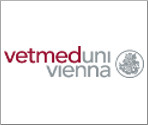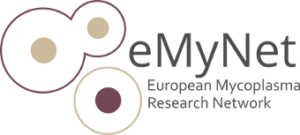
Institute for Microbiology Department of Pathobiology
Veterinärmedizinische Universität Wien
Applied Mycoplasmology
Applied mycoplasma research topics are predominantly related to the clinical significance, developments in diagnostics and the molecular epidemiology of mycoplasma infections in different animal hosts including livestock, companion animals and wildlife.
Modern diagnostic veterinary Mycoplasmology represents the key interface between laboratory microbiology and clinical science providing rapid, high-quality and clinically-relevant diagnosis of mycoplasma diseases based on applying standard methods and innovative approaches for the detection and identification of animal mycoplasmas. Difficulties in identifying mycoplasma isolates have been circumvented by the application of MALDI TOF MS employing a large in-house database, significantly improving the identification of more than 120 currently known animal mycoplasma species and even the detection of new mycoplasma species leading to an increase in diagnosis and identification of specific infections in the animal host.
The epidemiology of certain mycoplasma infections (e.g. M. bovis, M. agalactiae, M. hyopneumoniae) have been investigated by genome-based genotyping methods (e.g. MLVA, MLST, SNP-based genotyping) allowing tracing of infections and providing information regarding evolutionary and functional bacterial diversity. With the increasing number of sequenced genomes of mycoplasma reference and field strains (currently also in process by our group) and implementation of further typing approaches our intention is to continue, extend and enhance this research on the epidemiology of mycoplasma infections relevant to the veterinary field.
Further reading
- Spergser et al. High prevalence of mycoplasmas in the genital tract of asymptomatic stallions in Austria. Vet Microbiol. 2002 Jun 20; 87(2): 119-29.
- Spergser et al. Mycoplasma mucosicanis sp. nov., isolated from the mucosa of dogs. Int J Syst Evol Microbiol. 2011 Apr; 61(Pt 4): 716-21. (https://doi.org/10.1099/ijs.0.015750-0)
- Nathues et al. RAPD and VNTR analyses demonstrate genotypic heterogeneity of Mycoplasma hyopneumoniae isolates from pigs housed in a region with high pig density. Vet Microbiol. 2011 Sep 28; 152(3-4): 338-45. (https://doi.org/10.1016/j.vetmic.2011.05.029)
- Spergser et al. Emergence, re-emergence, spread and host species crossing of Mycoplasma bovis in the Austrian Alps caused by a single endemic strain. Vet Microbiol. 2013 Jun 28; 164 (3-4): 299-306. (https://doi.org/10.1016/j.vetmic.2013.02.007)
- Bürki et al. A dominant lineage of Mycoplasma bovis is associated with an increased number of severe mastitis cases in cattle. Vet Microbiol. 2016 Nov 30; 196: 63-66. (https://doi.org/10.1016/j.vetmic.2016.10.016)
Molecular Genetic Dissection of Mycoplasma Pathogenesis
Virulence strategies of mycoplasmas are largely unknown. Understanding the undeniably complex pathogenicity determinants of these sophisticated pathogens is our primary research focus. Using M. agalactiae as a model for ruminant mycoplasmosis, this is primarily achieved by creating an invaluable set of transposon and ‘Phase-Locked’ mutants and using them in a variety of in vitro and in vivo studies .
Phase and antigenic variation
High frequency phase and antigenic variation exhibited by large multigene families are considered to play important roles in mycoplasma pathogenicity although direct studies proving the same are mostly lacking. Vpma ‘Phase-Locked’ Mutants (PLMs) serve as powerful tools in elucidating the significance of individual Vpma proteins and their variation during infection studies in the sheep infection model and also by employing several in vitro assays. The combination has clearly proven the role of Vpmas as immune evasion proteins of M. agalactiae playing important role in the survival and persistence of the pathogen. Having demonstrated their differential in vivo pathogenicity potential, and their novel role as major adhesins mediating differential adhesion and invasion of different Vpma clonal variants, we intend to extrapolate the studies on the homologous Vsp phase variation system of M. bovis.
Further reading
- Chopra-Dewasthaly et al. Vpma phase variation is important for survival and persistence of Mycoplasma agalactiae in the immunocompetent host. PLoS Pathog. 2017 Sep 28; 13 (9): e1006656. (https://doi.org/10.1371/journal.ppat.1006656)
- Czurda et al. Xer1-independent mechanisms of Vpma phase variation in Mycoplasma agalactiae are triggered by Vpma-specific antibodies. Int J Med Microbiol. 2017 Dec; 307 (8): 443-451. (https://doi.org/10.1016/j.ijmm.2017.10.005)
- Hegde et al. Novel role of Vpmas as major adhesins of Mycoplasma agalactiae mediating differential cell adhesion and invasion of Vpma expression variants. Int J Med Microbiol. 2018 Mar; 308 (2): 263-270. (https://doi.org/10.1016/j.ijmm.2017.11.010)
Pathogenicity-associated genes
Simultaneous screening of transposon mutants has identified several important genes involved in host colonization and/or systemic spreading during experimental infections of lactating ewes via the intramammary route. With further characterization of these mutants and defining the precise functions of the identified genes we anticipate to increase our understanding of ruminant mycoplasmoses and to develop successful intervention strategies.
Further reading
- Hegde et al. Simultaneous Identification of Potential Pathogenicity Factors of Mycoplasma agalactiae in the Natural Ovine Host by Negative Selection. Infect Immun. 2015 Jul; 83 (7): 2751-61. (https://doi.org/10.1128/IAI.00403-15)
- Hegde et al. Genetic loci of Mycoplasma agalactiae involved in systemic spreading during experimental intramammary infection of sheep. Vet Res. 2016 Oct 20; 47(1): 106. (https://doi.org/10.1186/s13567-016-0387-0)
Mycoplasma-host interface at the molecular cellular level
In vitro and in vivo demonstration of cell invasion and systemic spreading of M. agalactiae into distant inner organs during experimental sheep infections has prompted us to investigate the processes of cytadhesion and invasion in detail. We are interested in knowing the interactive partners on both sides and to understand the nature of cytopathic effects leading to disease. In order to dissect the molecular genetic mechanisms underlying mycoplasmosis it is also important to know about the induced host responses, which we are addressing via the transcriptomics approach and immune studies.
Further reading
- Hegde et al. In vitro and in vivo cell invasion and systemic spreading of Mycoplasma agalactiae in the sheep infection model. Int J Med Microbiol. 2014 Nov; 304(8): 1024-31. (https://doi.org/10.1016/j.ijmm.2014.07.011)
- Hegde et al. Mycoplasma agalactiae induces cytopathic effects in infected cells cultured in vitro. PLoS One. 2016 Sep 23; 11(9): e0163603. (https://doi.org/10.1371/journal.pone.0163603)
- Chopra-Dewasthaly et al. Comprehensive RNA-Seq profiling to evaluate the sheep mammary gland transcriptome in response to experimental Mycoplasma agalactiae Infection PLoS One. 2017 Jan 12; 12(1): e0170015. (https://doi.org/10.1371/journal.pone.0170015)
Host-Pathogen Interactions of M. gallisepticum at the Molecular Level
Bacterial virulence often is not based on the simple production of a toxin, but on the complex interplay of different strategies. Our role model to study genes and mechanisms underlying Mycoplasma pathogenicity is M. gallisepticum, the most important avian Mycoplasma. How this pathogen changes a first local infection into a systemic and persistent infection may strongly depend on its capacity to adhere to cells as well as to invade into cells and on its uncommon locomotion capability, the gliding motility.
Adherence & Gliding Motility
Cytadherence of M. gallisepticum might be a multifactorial process where extracellular matrix binding proteins and variable lipoproteins contribute to the binding activities of the main adherence molecules, GapA and CrmA. GapA´s presence on the surface seems to be mutually dependent on CrmA, and also underlies the mechanisms of phase-variation. As adherence is a prerequisite of gliding motility, GapA and CrmA are also involved in M. gallisepticum´s locomotive abilities. Our interest is to dissect and allocate –on the molecular level- the contribution of single domains of the main adherence proteins to motility and to adherence.
Our group was the first to report on motility-related genes of M. gallisepticum. However, only a subset of genes (mgc2, gapA, crmA) could be identified in a first approach. Many more motility genes are awaiting their discovery! And, even more thrilling, the elucidation of the mechanism how M. gallisepticum is able to glide will probably reveal a new concept aside from the centipede and inchworm locomotion models of
M. mobile and M. pneumoniae.
Cell Invasion
More and more mycoplasma species are no longer considered as exclusively extracellular pathogens. Already in 2000, our group reported M. gallisepticum be cell-invasive for non-phagocytic cells in vitro and in 2013 the pathogen was proven to invade erythrocytes of experimentally M. gallisepticum-infected chickens. While we also found some extracellular matrix proteins to exert positive effects on adhesion and invasion of M. gallisepticum, not much is still known about the mechanism or the bacterial proteins involved in cell invasion. It is our intention to continue research on this very important topic that might be the underlying cause of M. gallisepticum´s ability to persist and to overcome antibiotic eradication regimes (also well-known when dealing with mycoplasmas as contaminants of cell cultures).
Vaccine development
The elucidation of the molecular players of the cell invasion process or the proteins involved in
M. gallisepticum gliding motility might point us to the most promising candidates for vaccine development which still is the motivation for undertaking the basic research on M. gallisepticum virulence factors.
Molecular Tools
Basic research at the molecular level strongly depends on the availability of appropriate molecular cloning tools: plasmids, transposons, promoters (particularly desirable: inducible promoters), markers, resistance genes. We are constantly expanding our existing tool box and developing new methods.
Further reading
- I. Indiková et al. Role of the GapA and CrmA cytadhesins of Mycoplasma gallisepticum in promoting virulence and host colonization. Infect. Immun. 2013; 81 (5):1618-24. (https://doi.org/10.1128/IAI.00112-13)
- G. Vogl et al. Mycoplasma gallisepticum invades chicken erythrocytes during infection. Infect. Immun. 2008; 76: 71-77. (https://doi.org/10.1128/IAI.00871-07)
- I. Indiková et al. First identification of proteins involved in motility of Mycoplasma gallisepticum. Vet. Res. 2014; 45(1):99. (https://doi.org/10.1186/s13567-014-0099-2)
- U. Fürnkranz et al. Factors Influencing the Cell Adhesion and Invasion Capacity of Mycoplasma gallisepticum. Acta Vet. Scand. 2013; 55(1):63. (https://doi.org/10.1186/1751-0147-55-63)
- I. Niezner et al. Development of a Site-Directed Integration Plasmid for Heterologous Gene Expression in Mycoplasma gallisepticum. PLoS One 2013; (8), 11 e81481-e81481. (https://doi.org/10.1371/journal.pone.0081481)
Members
Renate ROSENGARTEN (renate.rosengarten@vetmeduni.ac.at)
Michael SZOSTAK (michael.szostak@vetmeduni.ac.at)
Joachim SPERGSER (joachim.spergser@vetmeduni.ac.at)
Rohini CHOPRA DEWASTHALY (rohini.chopra-dewasthaly@vetmeduni.ac.at)
Address
Institute of Microbiology
Department of Pathobiology
University of Veterinary Medicine Vienna
Veterinaerplatz 1, 1210 Vienna
AUSTRIA
